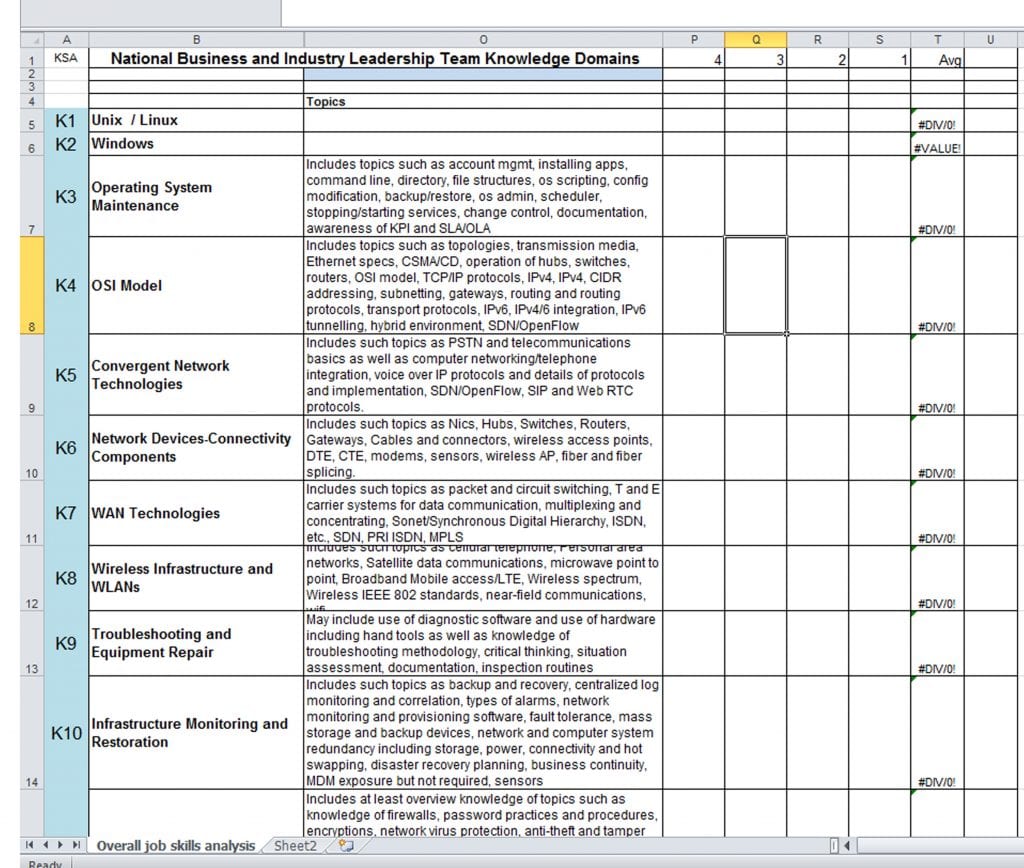Best Practices for Getting Feedback from Your Business Group
The National Convergence Technology Center (CTC) recently hosted a “job skills validation” meeting with the National BILT (Business and Industry Leadership Team). This annual meeting – which was attended by six business experts in person and another six on the phone – fulfills the BILT’s primary task: delivering specific feedback on the knowledge, skills, and abilities (“KSAs”) entry-level technicians need to be workforce-ready and get hired.
The National CTC has fine-tuned this “KSA process” to maximize the BILT’s time at the meeting and deliver to faculty a concrete overview of BILT recommendations. It’s a format that works. And it’s a format that any school can employ in any discipline. The National CTC believes these meetings – connecting curriculum and faculty to the businesses that hire new graduates – are the cornerstone to a successful program
Below is a list of some best practices for these job skills meetings you may want to consider when dealing with your own group of business and industry experts.
- Allow ample time for discussion. The National CTC’s quarterly meetings with the BILT are usually 90 minutes long. But the job skills meeting is longer. You want to be sure to give the business experts time to go over each job skill in detail. Typically, the National CTC job skills meetings run 8:30am-2:00pm.
- Provide amenities. As with any event, feeding (including hot coffee) attendees creates a happier, more cooperative atmosphere.
- Create structure for the feedback. The National CTC has developed a pro-forma list of job skills as an Excel file. During the meeting, rather than a free-flowing discussion that could end up a jumble in meeting minutes, the facilitator walks the BILT through the list one by one and solicits feedback. Do entry-level technicians need that skill? If so, at what level – a thorough know-how or a basic understanding? BILT members vote on each skill using a scale from 1 (least important) to 4 (most important). The votes are then averaged together.
Here’s a sample of our list:

- Update the list as you go. It’s better to have someone on a laptop in the room with the Excel file open to make edits and change to the job skills list during the meeting.
- Use that list to crosswalk back to your program. The best thing about this job skills list is that you end the meeting with an actionable takeaway document. Faculty members can see which job skills the BILT values, then map those back to the program courses to make sure everything is covered. If there are any gaps (skills the BILT wants to see that aren’t taught), then adjustments can be made to the courses.
- Have the discussion in the room. It’s tempting to gather votes asynchronously online by sending out the list and asking for feedback via e-mail. But there is immense value to hearing the BILT members discuss the job skills in real time in the room together. You want that mix of perspectives and opinions. There’s also a worry that if someone sends in vote via email, he or she will be less inclined to attend the meeting since there could be a sense of “I did my part.” For this reason, the National CTC waits until the last minute to send out the KSA Excel list to the meeting attendees.
- Remember the callers. If you do have some business experts on the phone, don’t forget to call on them periodically to keep them engaged in the discussion and record their votes. The National CTC recently started printing a sign to stand up next to the speaker phone that lists who’s on the phone – a visual reminder to everyone in the room that they’re not the only ones at the meeting.
- Clarify the evaluation criteria. To keep the discussions focused, be sure everyone understands how they’re evaluating the job skills. Ideally, the feedback and the votes are driven by the skills that an entry-level employee needs to get hired.
- Faculty are active listeners. It’s essential that faculty hear the feedback and votes directly from the BILT members. That carries the kind of weight that an intermediary document (like meeting minutes) may not. But it’s also important that faculty not interject. This is the chance for the BILT to offer their curriculum “Christmas list” – it’s what they want, which may not be what all of the faculty wants. The faculty can discuss later on their own whether what the BILT wants is possible. Don’t let the faculty mistakenly color or sidetrack the BILT’s discussions. They can also ask clarifying questions.
- End on time. Respect your BILT members’ busy schedules and adjourn when your agenda says you will adjourn.
For more information on this process, as well to hear best practices from other ATE centers, check out these CCTA webinar recordings:
“Effective Approaches for Aligning Curriculum with Business Demand”
“Successful Approaches for Ensuring Effective Business Engagement in Programs”
